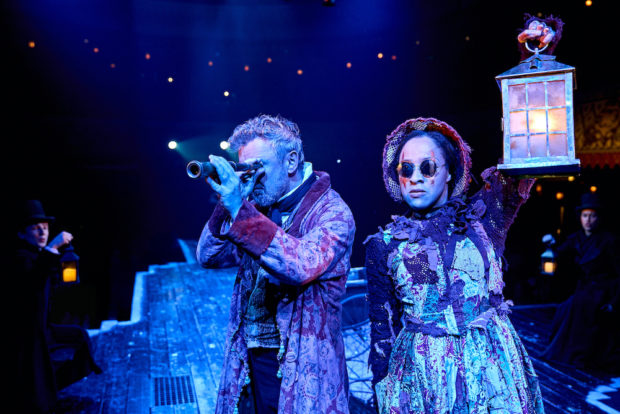A Christmas Carol, Old Vic
Wednesday 20th November 2024

This Dickens classic is an annual treat, or a Christmas trial — depending on your point of view. At the Old Vic, it was adapted by Jack Thorne in 2017, and like the holly and the ivy has been a hardy perennial ever since. Here Scrooge has been played by stars such as Rhys Ifans, Paterson Joseph, Stephen Mangan and Christopher Eccleston. This time it’s the turn of John Simm. Over the years, this show — which transferred to Broadway, toured the US and was also staged in Melbourne — has raised about £1.5 million globally for food poverty charities. Although this is clearly a good thing, how does this vibrant prince of seasonal Dickens fare — complete with loud music and stamping dancing — come across to audiences today?
The short answer is that they love it. Populism rules. Beginning with a pre-show in which actors dressed as Victorian street sellers offer mince pies and tangerines to the spectators, while on stage a large cast of supernumeraries brim over with festive spirit before a single handbell is rung, or a single word spoken. When the story begins, the words at first are familiar quotations from the 1843 original, and a lot depends on everyone knowing, as they probably do, the outline of this archetypal tale of greed and redemption, which has been adapted time and time again since its first publication.
Because the story is so well-known Thorne feels free to make changes both playful and more serious to the original, while occasionally falling back on the exact words used by Dickens. The two most important changes involve deepening the psychology of the miser Ebenezer Scrooge, and altering the nature of two of the three spirits — the Ghosts of Christmas Past, Christmas Present and Christmas Yet to Come (here typically simplified to “Future”). Thorne’s insight is that Scrooge’s coldness, loneliness and emotional ferocity needs a back story, which he provides by introducing a cold, lonely and ferocious father, an abusive figure whose own indebtedness is passed onto his son as a passion for accumulating money.
Scrooge’s love of money is shown to have its origins in his fear of becoming as unhappy as his father, but gets an added boost from his ambition to succeed despite his impoverished origins. So in this A Christmas Carol Fezziwig is an undertaker (a nod perhaps to Oliver Twist), with an empathetic daughter Belle, who Scrooge the young apprentice falls in love with. The failure of this love lies not just in Scrooge’s love of gain, but also in the fact that he delays marriage in order to become very rich. Needlessly rich. Neurotically rich. This works very well on stage as it tidies up several strands of the original novella.
Simm’s performance of the miser, who offers spirited resistance to the three Ghosts, here all played by women and with one turned into a member of his family, gives the evening some dramatic moments, and the character is portrayed as growing slowly on the inevitable path of his secular salvation. While Thorne has dispensed with the services of the ghostly Ignorance and Want children (a mistake in my view), he does give a greater role to Tiny Tim and to Fan, Scrooge’s sister (mother of his nephew). Simm both masters the narrative arc of the show, and emerges beaming in this version’s extended ending.
That said, it has to be pointed out — I know, I know: I’m at risk of being the embodiment of an anti-Xmas killjoy — that much of Thorne’s playwriting really is appallingly patronizing. The text is so Simple Simon it grates. Everything is spelled out for the audience, every bit of charity talk is repeated so that even the slowest mind can grasp it — there is no subtext, no subtlety, no poetry (except for the occasional quotation from Dickens). This kind of preachiness really is a strain on the patience, even as the noisily compulsive festive cheer of the production rolls over the stalls and up into the circles. And then there’s a steaming turkey to fish off the list of clichés.
Director Matthew Warchus, with designer Rob Howell, have extended the stage into a runway that splits the stalls, and the staging involves thin door frames that rise from the floor and boxes with Scrooge and Marley’s name on them which can be put to work as chairs and desks. Christopher Nightingale has taken a series of familiar carols and arranged them for bellringing (beautiful in the case of “Silent Night”; annoying in most other passages) and with other dramatic music played by a small live orchestra (often so loud that the actors shout themselves hoarse in order to be heard). Still, there’s some nice singing, and great lighting effects by Hugh Vanstone help create the required spookiness.
As well as Simm’s good work as Scrooge, which in the quieter moments does achieve a much-needed emotional depth, the large cast are perfectly effective: Rob Compton as Bob Cratchit, Scrooge’s clerk and father of Tiny Tim; Juliette Crosbie’s sensible Belle; Georgina Sadler’s loving Fan; Jenny Fitzpatrick and Julie Jupp as the Ghosts of Christmas Present and Past; Alastair Parker does a lot with the small part of Fezziwig and casting Mark Goldthorp as both Scrooge’s father and Marley makes its own psychological point. There is a lot of theatricality here, from snowfall to brussels sprouts, ghostly lights to sudden apparitions, to delight those in need of festive cheer, but the compulsive grinning and happy smiles and uncomfortable audience participation reminds me that a crowd-pleasing evening really does depend on you wanting to be part of the crowd — and at this time of year I really don’t.
This review first appeared on The Arts Desk




